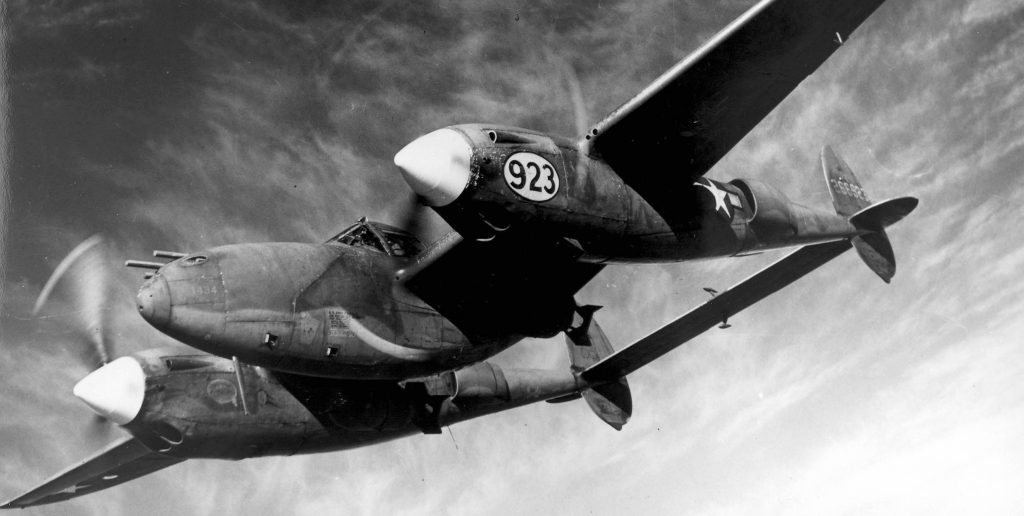
P-37 Lightning – Wikipedia
In the 1940’s as aircraft were being flown closer and closer to the speed of sound, they began experiencing strange characteristics. Aircraft buffeting similar to a stall, aileron vibrations or “buzz”, controls shaking, losing effectiveness, or even locking up. People were really scared of this “Deamon that lived in the air.”
The first American plane crash caused by “Mach Tuck” was in November 1941. A Lockheed P-38 Lightning, piloted by Ralph Virden, entered a high-speed dive and was unable to pull up from it. Virden had exceeded the critical Mach number during the dive. The elevator seemed to have frozen, and to make matters worse, the supersonic “burble” over the tail caused the nose to pitch down further. This phenomenon had been observed on other P-38’s, however, Ralph Virden was, unfortunately, the first to be taken by Mach Tuck
Mach Tuck or “tuck under” is a downward pitching moment that is sometimes experienced in a subsonic aircraft when exceeding the Critical Mach Number and, usually more-so, when exceeding the Fore Divergence Mach number causing Mach induced flow separation, or “compressibility burble” as it was sometimes called at the time.
Not all aircraft experience a tucking under effect as they approach the speed of sound. The experimental aircraft of the 40’s and 50’s designed to test transonic and supersonic speeds experience all sorts of characteristics depending on their design, including pitching up, rolling, controls “buzzing”, fluttering, and losing effectiveness. The Douglas D-558 Skyrocket would experience a violent pitch up to 45-60 degrees, then begin to roll violently resulting in a spin, which could then be recovered from. Most modern jet aircraft are designed to have nearly zero Mach tuck.
Critical Mach Number

As air flows over an airfoil, the air above the wing becomes accelerated. Because the air flowing above the wings is flowing faster than the airspeed of the aircraft, the air above the wing will reach the speed of sound at an airspeed well below Mach 1.0 such as Mach 0.72 for the airfoil shown above. The speed at which this happens is called the Critical Mach Number or MCRIT.

A shock wave will begin at the point where the speed of sound is reached, grow, and work its way backward as speed increases. This also causes the center of pressure and center of lift to begin to move aft.
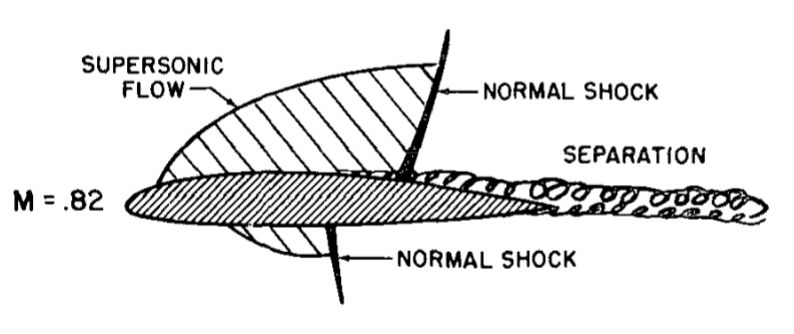
The critical Mach number happens at a lower speed if an airfoil is thick. The reason that the P-38 became the first aircraft to experience compressibility and Mach effects is that it had a very thick wing. This caused its critical Mach number to be about 0.68
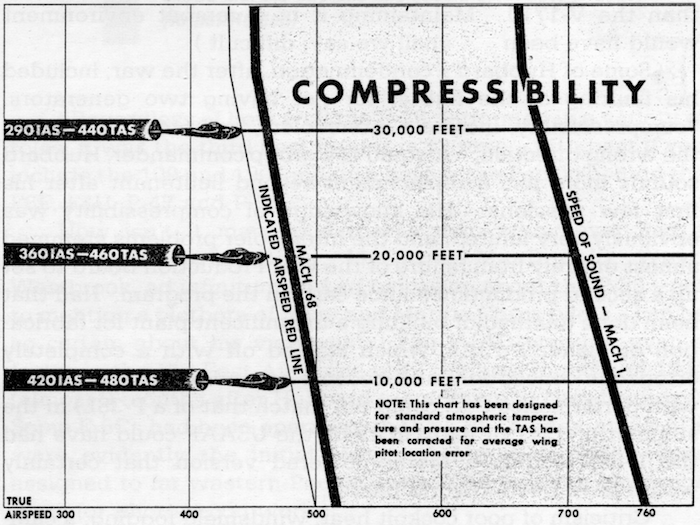
P-38 Compressibility Chart – Wikipedia.com
It’s also important to understand that the critical Mach number on an aircraft can be caused by a location other than the wing. Air accelerating over an engine nacelle, wingtip tank, or any location may be the first location where local airspeed reaches the speed of sound.
Force Divergence Mach Number
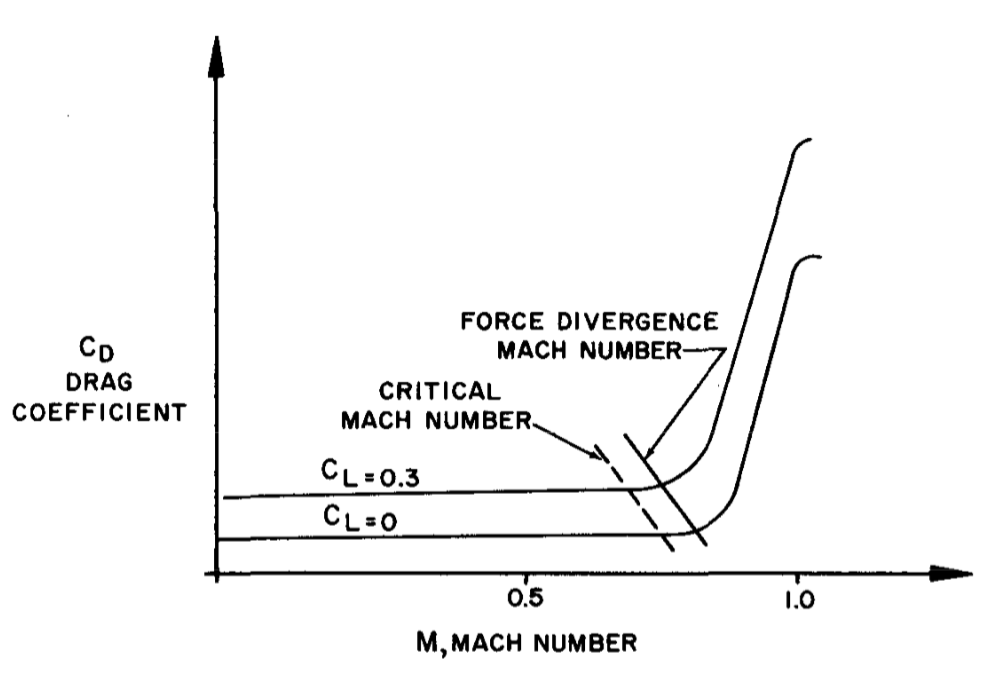
At a speed above M-Crit, airflow will begin to separate from the wing similarly to during a stall. This separation will happen even at zero angles of attack. When this separation begins, the aerodynamic drag on the airfoil will begin to increase rapidly. The Mach number when this rapid drag increase begins is called the drag divergence Mach number. This separation was once also called “compressibility burble” (they used to call an aerodynamic stall a “burble” too).
The force divergence tends to move the center of pressure even farther rearward.
The rearward moving center of pressure causes the center of lift to move rearward which could cause a downward pitching moment, especially on swept wing aircraft.
Also as the drag increases sharply, the lift also decreases drastically, sometimes causing the aircraft to drop. The loss in lift reduces the downwash caused by the wings. This rapid reduction of downwash flowing over the tail can reduce the downward force from the horizontal stabilizer on conventional aircraft and also cause the nose to pitch down more.
The reason most jet aircraft have a T-Tail design is to reduce these effects by keeping the tail out of the way of downwash.
For aircraft not designed to fly at speeds above Mach 1, the downward pitching moment is very bad. The airspeed continues to increase, and most likely exceed the structural limitations of the aircraft.
Mach Tuck on Modern Aircraft
The characteristics of Mach tuck can be thought of as being similar to stall characteristics of an aircraft — Every aircraft design is different. Just as some aircraft stall abruptly, possibly wanting to spin right or left, some aircraft stall slowly, while others hardly drop at all during a stall.
Fortunately, nearly all modern aircraft have been designed to eliminate all of the previously mentioned problems as the speed of sound is approached.
Supersonic military aircraft are now designed so that passing the speed of sound is a non-event.
Many subsonic passenger aircraft are designed to fly past the critical Mach number without any sign of Mach tuck. The maximum Mach number (Mmo) of passenger jets is typically set so that, although they may exceed the critical Mach number, they do not reach the force divergence Mach number, and will not begin to tuck under.
During the initial manufacturer flight testing, if an aircraft has a tendency to begin to “tuck” as it approaches the Mmo, the aircraft design is required to be fixed with some change in the aerodynamics or the use of Mach Trim, or stick puller, which will pull the nose upward to slow the aircraft.
Some notorious aircraft that still did have trouble with this was the DC-8 and the early LearJets.
Operational Considerations
Typically, the only time you would have to worry about Mach tuck, or Mach effects while flying a civilian aircraft would be if you had exceeded the published limitations, or if turbulence or aircraft malfunction had caused you to exceed those limitations.
The best advice is to always avoid possible over-speed situations!
- ALWAYS COMPLY WITH THE AIRCRAFT LIMITATIONS!
- Avoid maximum operating altitudes if turbulence is suspected
- Watch out for wake turbulence of aircraft crossing above you
- Avoid any unusual attitudes or abrupt maneuvering at high altitudes
- Be cautious with your airspeed when beginning a descent
- Learn how your specific aircraft handles as it approaches or accidentally exceeds MMO
If you do find yourself in an over-speed situation
- FOLLOW THE OPERATING PROCEDURES!
- Reduce the power
- Use gentle control movements and raise the nose to slow down – Don’t yank back!
- Extend speed Brakes? On some aircraft, they could aggravate the problem
- Drop the Landing Gear? Again, you need to know your specific aircraft
The typical reflex when a pilot experiences a nose-down pitching moment is to pull back on the elevator. This can make the problem worse by increasing the load factor (which lowers coffin corner), and also by increasing the speed of local airflow over the wings, both of which will cause the aircraft to go deeper into the Mach tuck. Deploying speed-brakes in some aircraft will also aggravate the situation by causing the nose to pitch down even more.
LearJet
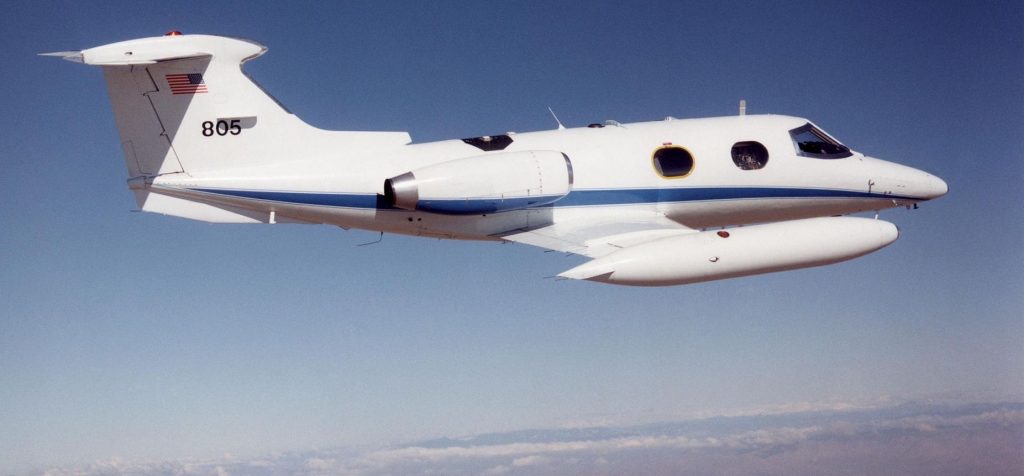
The early Learjet models were notorious for being difficult to fly and possibly dangerous due to Mach tuck, force divergence, dutch roll, or other high-speed high altitude concerns.
After a Learjet 24 crashed in 1980, the Gates Learjet company issued a service newsletter containing the following information:
“At Mach Numbers in excess of Mmo, aileron activity could be encountered, and this activity increases in amplitude as Mach Number is increased. This activity has been described as aileron “buzz” or aileron “snatch” and is a random frequency and amplitude movement of the ailerons and control wheel. Pulling “g’s” in that regime of flight increases the aileron activity, so one must not pull abruptly on the elevator control to slow the aircraft, but must apply a steady force of the magnitude necessary to produce as much “g” force as possible without losing roll control. Exceeding Vmo in the lower Mach Number regime produces higher recovery elevator control forces, but no aileron activity. Another phenomenon .which occurs at Mach Numbers beyond the red line is “Mach Tuck.” This phenomenon is caused by aft movement of the wing center of pressure and results in a nose-down pitching moment. The stick puller is provided as a device to ensure no excursion beyond. It should never be turned off during normal operation of the aircraft. If for any reason, there is a malfunction that requires turning off the stick puller, the aircraft should be operated at speeds well below Mmo as prescribed in the applicable Flight Manual procedures. As in any airplane, speeds beyond the red line must be avoided by maintaining the desired attitude with appropriate flight controls and by decreasing thrust while executing the prescribed Emergency Procedures.
NOTE: IF Mmo IS INADVERTENTLY EXCEEDED TO THE POINT WHERE THE PLANE SEEMS TO BE OUT OF CONTROL, LOWER THE LANDING GEAR. The landing gear doors may be lost or damaged, but the main concern is to facilitate recovery by using the extended gear to slow the forward speed of the airplane.
Spoilers – The use of the spoilers is not prescribed in Pitch Axis Malfunction and Runaway Trim Emergency Procedures. The reason is that the nose down pitch change which the spoilers produce may aggravate pitch down problems.
